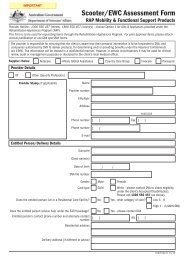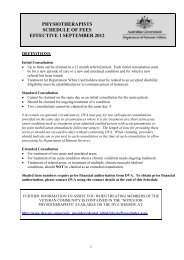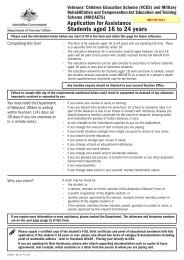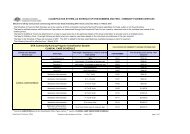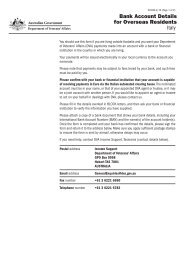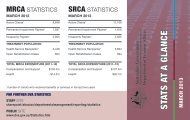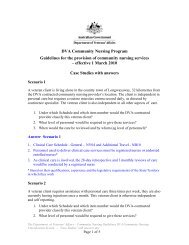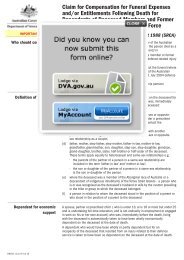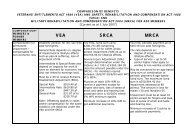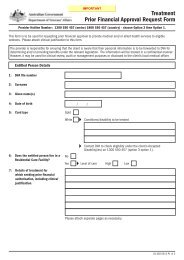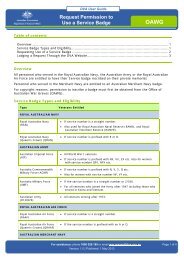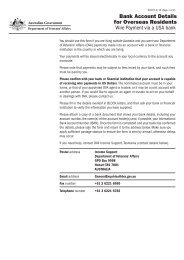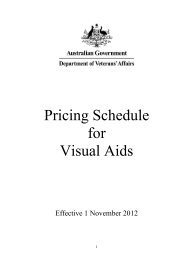Download pp. 1-40 (PDF 6.2MB) - Department of Veterans' Affairs
Download pp. 1-40 (PDF 6.2MB) - Department of Veterans' Affairs
Download pp. 1-40 (PDF 6.2MB) - Department of Veterans' Affairs
Create successful ePaper yourself
Turn your PDF publications into a flip-book with our unique Google optimized e-Paper software.
Ko a<br />
odapua Exploring the Second WKorld War campaign in P New Guinea
Kokoda: Exploring the Second World War campaign in Papua New Guinea<br />
© Commonwealth <strong>of</strong> Australia 2012<br />
This work is copyright.<br />
Permission is given by the Commonwealth for this publication to be copied royalty free within Australia solely for educational purposes. Apart from any use as permitted<br />
under the Copyright Act 1968, no part may be reproduced for commercial purposes.<br />
Requests and inquiries concerning reproduction and rights should be addressed to the Commonwealth Copyright Administration, Attorney-General’s <strong>Department</strong>, Robert<br />
Garran Offices, National Circuit, Barton ACT 2600 or posted at www.ag.gov.au/cca.<br />
To the best <strong>of</strong> DVA’s knowledge, copyright permission has been obtained for any non-Commonwealth material used in this booklet and for the use <strong>of</strong> such material for<br />
educational purposes. The Commonwealth shall not be responsible for any actions resulting from any errors or omissions contained in this booklet. If you believe there<br />
has been an error or omission in any <strong>of</strong> the material, please contact DVA at commemorations@dva.gov.au.<br />
Front cover images: AWM 013285 Australian John Hannam handles a Bren gun. (Damion Parer). Beaver Machine Gun in jungle, image courtesy <strong>of</strong> Jason Daniels, DVA.<br />
Bomana Cemetery image courtesy <strong>of</strong> Tim Adams, DVA.<br />
Back cover images: AWM REL/08602 Autographed good luck flag carried by Japanese soldier. AWM 027058 October 1942. Four soldiers <strong>of</strong> the 2/31st Australian Infantry<br />
Battalion.<br />
For inquiries about reproduction or other uses <strong>of</strong> this publication contact:<br />
Commemorations Group<br />
<strong>Department</strong> <strong>of</strong> Veterans’ affairs<br />
GPO Box 9998<br />
CANBERRA ACT 2601<br />
Tel: (02) 6289 1111<br />
Fax: (02) 6289 4849<br />
Email: commemorations@dva.gov.au<br />
Information is current at date <strong>of</strong> publication.<br />
ISBN: 978-1-877007-68-2<br />
PO2191<br />
Published by the <strong>Department</strong> <strong>of</strong> Veterans’ <strong>Affairs</strong>, Canberra, March 2012.<br />
Designed by Fivefold Creative
1<br />
2<br />
3<br />
4<br />
5<br />
6<br />
Contents<br />
Page<br />
Using the publication in the classroom 3<br />
Recommended publications for teachers 5<br />
Glossary <strong>of</strong> terminology 6<br />
UNIT 1: about the Kokoda Track: 1942 and Today 9<br />
Why is the Kokoda Track significant? 10<br />
Activity 1. The topography <strong>of</strong> Kokoda 12<br />
Activity 2. Australian tourism on the Kokoda Track 14<br />
Activity 3. Depth study: Flight Sergeant Croud 16<br />
UNIT 2: The War in Papua: The Strategic Context 19<br />
What was the strategic importance <strong>of</strong> Kokoda? 20<br />
Activity 1. The strategic context 22<br />
Activity 2. Why was Port Moresby important? 24<br />
UNIT 3: Four Peoples at War 27<br />
Who were the four peoples fighting in New Guinea in 1942? 28<br />
Activity 1. Four peoples at war 30<br />
Activity 2. Fuzzy Wuzzy Angels 34<br />
UNIT 4: Jungle Warfare 41<br />
What were the fighting conditions like in jungle warfare? 42<br />
Activity 1. Fighting conditions and personal challenges 44<br />
Activity 2. Malaria and dysentry research project 47<br />
UNIT 5: a Fighting Retreat 49<br />
What was the outcome <strong>of</strong> the second engagement<br />
at Kokoda: August – September 1942? 50<br />
Activity 1. Second engagement at Kokoda 52<br />
Activity 2. Walking the Kokoda Track 55<br />
UNIT 6: Into the Mountains 59<br />
What ha<strong>pp</strong>ened in the Australian retreat from Eora<br />
to Templeton’s Crossing: 31 August – 5 September 1942? 60<br />
Activity 1. The engagement at Eora 63<br />
Activity 2. Was the reputation <strong>of</strong> the 53rd Battalion deserved 67<br />
KOKODA<br />
1
7<br />
8<br />
9<br />
10<br />
11<br />
12<br />
2 KOKODA<br />
UNIT 7: Milne Bay 69<br />
What led to the Japanese defeat at Milne Bay? 70<br />
Activity 1. The Japanese landing and defeat at Milne Bay 72<br />
Activity 2. Milne Bay – veteran account 74<br />
Activity 3. Depth study: Corporal John Alexander French VC 76<br />
UNIT 8: The Tide Turns 79<br />
Did General Blamey mean to insult the troops in his ‘rabbit speech’? 80<br />
Activity 1. Esma Myer’s story 82<br />
Activity 2. General Blamey and the ‘rabbit speech’ 84<br />
Activity 3. Perspectives <strong>of</strong> war by analysing historical sources 86<br />
UNIT 9: The Japanese Besieged – The Battle <strong>of</strong> the 91<br />
Beachheads: Buna, Gona, Sanananda<br />
What is a siege? 92<br />
Activity 1. Battle brainstorm 95<br />
Activity 2. Beachheads – word puzzle 97<br />
UNIT 10: Casualties 99<br />
What is the definition <strong>of</strong> a casualty? 100<br />
Activity 1. Buna casualties 103<br />
Activity 2. Casualty evacuation and repatriation logistics 106<br />
* This Unit contains images <strong>of</strong> dead bodies and may distress some students<br />
UNIT 11: Kokoda Veterans’ accounts 109<br />
What do veterans remember most about the war? 112<br />
Activity 1. Australian veterans <strong>of</strong> Kokoda 113<br />
Activity 2. Japanese veterans <strong>of</strong> Kokoda 115<br />
UNIT 12: Commemoration and the Modern Pilgrimage 117<br />
Commemoration: what is a pilgrimage? 118<br />
Activity 1. Commemoration 120<br />
Activity 2. Pilgrimage 121<br />
Activity 3. Evaluation 122<br />
What I know about Kokoda 122<br />
Historical source evaluation 124
KoKoda<br />
Exploring the Second World War campaign in Papua New Guinea<br />
Using the publication in the classroom<br />
About <strong>Department</strong> <strong>of</strong> Veterans’ <strong>Affairs</strong><br />
(DVA) education publications<br />
Kokoda: Exploring the Second World War campaign in Papua<br />
New Guinea has been developed to mark the 70th anniversary<br />
<strong>of</strong> the battle along the Kokoda Track and was distributed to<br />
Australian secondary schools.<br />
This guidebook is a classroom resource which draws on and<br />
encourages the use <strong>of</strong> the website www.kokoda.commemoration.<br />
gov.au. The resource also links to other websites commissioned<br />
by the DVA such as www.ww2australia.gov.au and includes the<br />
documentary Kokoda on a separate DVD ROM.<br />
Australian Curriculum<br />
This teachers’ guidebook meets the requirements for the WWII<br />
Depth Study Elective, Modern History Unit 3 identified in the<br />
Australian Curriculum for History. It is a rich source <strong>of</strong> information,<br />
images, animated maps and interviews which aligns with the history<br />
curriculum for years 7-10. The guidebook encourages teachers to<br />
provide inquiry based learning activities and promotes historical<br />
literacy through the use <strong>of</strong> primary source documents.<br />
Information and Communications<br />
Technology (ICT)<br />
The Kokoda units encourage students to incorporate ICT skills into<br />
their classroom learning by providing activities utilizing websites<br />
and the Kokoda documentary. The units also invite historical<br />
interpretation using other evidence sources and multimedia.<br />
About the teachers’ guidebook<br />
The guidebook has twelve units with varied teaching and learning<br />
activities. The units explore the Kokoda website www.kokoda.<br />
commemoration.gov.au about the battle fought in New Guinea by<br />
Australians and Japanese during the Second World War. The resource<br />
<strong>of</strong>fers a focus question for each unit and range <strong>of</strong> teaching and<br />
learning activities.<br />
Components <strong>of</strong> this publication<br />
The Kokoda publication includes:<br />
• This twelve unit teachers’ guidebook;<br />
• CD ROM with su<strong>pp</strong>orting material for some units<br />
• The Kokoda documentary on DVD ROM<br />
• Two large posters with accompanying teaching<br />
activities on the CD ROM<br />
Educational aims<br />
The twelve units are to be used for inquiry-based learning to develop<br />
historical literacy skills through exploring the concepts <strong>of</strong> chronology,<br />
continuity and change, cause and effects, empathy, significance,<br />
perspective and interpretation and contestability. Within these units<br />
there is an increasing emphasis on historical interpretation, the<br />
analysis and use <strong>of</strong> sources, and the use <strong>of</strong> evidence.<br />
About the Kokoda website<br />
The website www.kokoda.commemoration.gov.au contains original<br />
research conducted by Dr Peter Williams and was commissioned<br />
by the <strong>Department</strong> <strong>of</strong> Veterans’ <strong>Affairs</strong>. The site continues to have<br />
materials added. Access to the website will enhance students<br />
learning through the twelve units.<br />
About the Photographic Images<br />
Images used throughout the book and the CD ROM have been<br />
sourced from the collections <strong>of</strong> the Australian War Memorial (AWM)<br />
and private collections. Some <strong>of</strong> the images contain dead bodies.<br />
This may be distressing for some students and teachers should<br />
use the materials with discretion with their students.<br />
Disclaimer<br />
The <strong>Department</strong> <strong>of</strong> Veterans’ <strong>Affairs</strong> cannot be assumed to agree<br />
with or endorse any content or opinions expressed in the websites<br />
or other publication quoted or referred to in this resource.<br />
How the activities link with the Australian<br />
Curriculum (www.acara.edu.au)<br />
The Australian Curriculum sets out the History Curriculum into two<br />
interrelated strands: Historical Knowledge and Understanding, and<br />
Historical Skills.<br />
The relationship between these two strands are explored through<br />
concepts for developing historical understanding, such as: evidence,<br />
continuity and change, cause and effect, perspectives, empathy,<br />
significance and contestability. This guidebook provides teaching and<br />
learning activities to develop these historical skills and maximise the<br />
interrelationship between historical knowledge and understanding.<br />
Teachers should describe, explain, model and monitor the process<br />
<strong>of</strong> historical inquiry so that students develop increasing initiative,<br />
self-direction and expertise. A variety <strong>of</strong> teaching and learning<br />
a<strong>pp</strong>roaches and activities can be used, including teacher exposition,<br />
student debates, site visits, museum studies, use <strong>of</strong> historical<br />
narrative and hands-on activities such as the use and interpretation<br />
<strong>of</strong> authentic and virtual artefacts. The end result <strong>of</strong> historical inquiry<br />
should be a well-su<strong>pp</strong>orted response to the question posed.<br />
KOKODA<br />
3
The Australian History Curriculum aims to ensure that students<br />
develop:<br />
• interest in, and enjoyment <strong>of</strong>, historical study for lifelong learning<br />
and work, including their capacity and willingness to be informed<br />
and active citizens;<br />
• knowledge, understanding and a<strong>pp</strong>reciation <strong>of</strong> the past and the<br />
forces that shape societies, including Australian society;<br />
• understanding and use <strong>of</strong> historical concepts, such as evidence,<br />
continuity and change, cause and effect, perspectives, empathy,<br />
significance and contestability; and<br />
• capacity to undertake historical inquiry, including skills in<br />
the analysis and use <strong>of</strong> sources, and in explanation and<br />
communication.<br />
Modern History Curriculum depth studies<br />
There are three depth studies outlined in the Modern History<br />
Curriculum. For each depth study, there are up to three electives that<br />
focus on a particular society, event, movement or development.<br />
It is expected that one elective will be studied in detail. The content<br />
in each depth study elective is designed to allow detailed study<br />
<strong>of</strong> specific aspects <strong>of</strong> this historical period. Kokoda is one <strong>of</strong> these<br />
electives.<br />
Using the Kokoda DVD<br />
A two part documentary by Film Australia, Film Victoria and Pericles<br />
Films PTY Ltd<br />
Each <strong>of</strong> the two parts <strong>of</strong> the Kokoda DVD are a<strong>pp</strong>roximately one hour.<br />
The two parts are The Invasion and The Counter Attack.<br />
4 KOKODA<br />
Australian Curriculum Depth Study: Modern<br />
History, World War II (1939–45)<br />
CONTENT<br />
The experiences <strong>of</strong> Australians<br />
during World War II (such as<br />
Prisoners <strong>of</strong> War (POWs), the<br />
Battle <strong>of</strong> Britain, Kokoda, the<br />
Fall <strong>of</strong> Singapore)<br />
ELABORATION<br />
Explaining the significance<br />
<strong>of</strong> Kokoda as the battle that<br />
halted the Japanese advance<br />
on Port Moresby and helped<br />
foster the Anzac legend.<br />
Additional Curriculum information<br />
Additional information on year level history curriculum achievement<br />
standards are provided on the CD ROM.<br />
How the DVD relates to the teachers’<br />
guidebook<br />
The DVA Kokoda website and Teachers’ Guidebook do not<br />
correspond specifically to the themes and analysis put forward<br />
by Paul Ham in the Kokoda DVD ROM. However, the Kokoda DVD<br />
ROM forms a critical source <strong>of</strong> evidence and good su<strong>pp</strong>ort material<br />
activities in this publication. These are outlined at the start <strong>of</strong><br />
each unit.<br />
Alternatively, you may wish to view each part <strong>of</strong> the documentary<br />
as a discrete activity.<br />
Further information on using the DVD ROM is provided on the<br />
CD ROM.
Recommended publications for teachers<br />
Books – Reference<br />
Peter Brune, Those Ragged Bloody Heroes: from the Kokoda Trail to Gona Beach 1942, North Sydney, 1991.<br />
Peter Brune, The Spell Broken: Exploding the Myth <strong>of</strong> Japanese Invincibility: Milne Bay to Buna-Sanananda<br />
1942-43, St Leonards, 1998.<br />
Chris Coulthard-Clark, Where Australians Fought: The Encyclopedia <strong>of</strong> Australia’s Battles, St Leonards, 1998.<br />
Douglas Gillison, Australia in the War <strong>of</strong> 1939-45; Series Three, Air, Vol 1 – Royal Australian Air Force 1939-1942,<br />
Canberra, 1962.<br />
Dennis Grey, Morris, Prior, Connor (eds), The Oxford Companion to Australian Military History, Melbourne, 1999.<br />
Jeffrey Grey, A Military History <strong>of</strong> Australia, Melbourne, 1990.<br />
Paul Ham, Kokoda, Harper Collins, Sydney, 2004.<br />
Dudley McCarthy, Australia in the War <strong>of</strong> 1939-45; Series One, Army, Vol V – South-West Pacific Area – First Year,<br />
Kokoda to Wau, Canberra, 1959.<br />
Raymond Paull, Retreat from Kokoda: The Australian Campaign in New Guinea 1942, Melbourne, Heinemann, 1958.<br />
John Robertson, Australia at War 1939-1945, Melbourne, Heinemann, 1981.<br />
Websites<br />
Australians at War Film Archive www.australiansatwarfilmarchive.gov.au/aawfa/<br />
Australia’s War 1939-1945 www.ww2australia.gov.au<br />
Australian War Memorial www.awm.gov.au<br />
<strong>Department</strong> <strong>of</strong> Veterans’ <strong>Affairs</strong> www.dva.gov.au<br />
Kokoda www.kokoda.commemoration.gov.au<br />
National Library <strong>of</strong> Australia www.nla.gov.au<br />
Kokoda Track Authority www.kokodatrackauthority.org<br />
Valuable information about tourism and trekking in the Kokoda Track corridor.<br />
The Kokoda Initiative www.environment.gov.au/heritage/internationalprojects/kokoda/index.html<br />
Kokoda Track Foundation www.kokodatrackfoundation.org<br />
Valuable information about su<strong>pp</strong>orting the communities along the Kokoda Track.<br />
KOKODA<br />
5
Glossary <strong>of</strong> terminology<br />
Artefact<br />
Something made or given shape by humans, such as a piece <strong>of</strong><br />
pottery or a stone tool made from flint.<br />
Asia<br />
Refers to the territorial area that extends from the western border <strong>of</strong><br />
Pakistan, to the northern border <strong>of</strong> Mongolia, the eastern border <strong>of</strong><br />
Japan, and extends to the southern border <strong>of</strong> Indonesia.<br />
Cause and effect<br />
In an historical context, ‘cause’ refers to the range <strong>of</strong> reasons for an<br />
historical event or development (including the influence <strong>of</strong> particular<br />
motives, values and attitudes) and ‘effect’ to the range <strong>of</strong> outcomes<br />
or consequences (both intended and unintended). Causes and effects<br />
may be short and/or long term.<br />
Chronology<br />
Sequence <strong>of</strong> time where events and dates are placed in order, as in<br />
a timeline.<br />
Contestability<br />
This occurs when particular interpretations about the past are open<br />
to debate, for example, as a result <strong>of</strong> a lack <strong>of</strong> evidence or different<br />
perspectives.<br />
Continuity and change<br />
Aspects <strong>of</strong> the past that remained the same over certain periods<br />
<strong>of</strong> time are referred to as continuities. Continuity and change are<br />
evident in any given period <strong>of</strong> time and concepts such as progress<br />
and decline may be used to evaluate continuity and change.<br />
Demography<br />
The study <strong>of</strong> the characteristics <strong>of</strong> human populations, such as their<br />
size, geographic distribution and composition; for example, age<br />
pr<strong>of</strong>ile and cultural makeup.<br />
Empathy<br />
The capacity to enter into the world <strong>of</strong> the past from the point <strong>of</strong> view<br />
<strong>of</strong> a particular individual or group, including an a<strong>pp</strong>reciation <strong>of</strong> the<br />
circumstances they faced, and the motivations, values and attitudes<br />
behind their actions or lack <strong>of</strong>.<br />
Evidence<br />
Evidence refers to the information, obtained from sources (that is, the<br />
remains <strong>of</strong> the past), for example written records and tomb paintings,<br />
that prove or disprove a conclusion. It can be used to establish the<br />
fact or point in question.<br />
Flank<br />
The left or right hand side <strong>of</strong> a military force.<br />
6 KOKODA<br />
Historical inquiry<br />
This is the process <strong>of</strong> developing knowledge and understanding by<br />
posing questions about the past and a<strong>pp</strong>lying skills associated with<br />
locating, analysing, evaluating and using sources as evidence to<br />
develop an informed and defensible interpretation. Historical inquiry<br />
is particularly concerned with the reasons for events.<br />
Imperialism<br />
The policy <strong>of</strong> extending the control or authority over foreign territory,<br />
particularly through the creation <strong>of</strong> an empire.<br />
Industrialism<br />
An economic and social system, <strong>of</strong>ten involving machinery and the<br />
concentration <strong>of</strong> workers in cities, that involves the production <strong>of</strong><br />
large quantities <strong>of</strong> goods on a large scale.<br />
Interpretation<br />
A conclusion that provides an explanation <strong>of</strong> the past, for example<br />
for a specific event or development. The discipline <strong>of</strong> history<br />
acknowledges that there will be more than one view <strong>of</strong> what<br />
ha<strong>pp</strong>ened in the past.<br />
Narrative<br />
A story about the past, such as a specific event or experience, or a<br />
recount <strong>of</strong> a series <strong>of</strong> past events.<br />
Nationalism<br />
The loyalty and devotion <strong>of</strong> a person to their nation and its culture.<br />
Oral histories<br />
The recording <strong>of</strong> people’s personal recollections <strong>of</strong> the past, usually<br />
through an audio or video-taped interview.<br />
Perspective<br />
Is a point <strong>of</strong> view from which historical events, problems and<br />
issues can be analysed. For example, a gender perspective (either<br />
masculine or feminine) <strong>of</strong> the past. The way that events are seen in<br />
the present may be different to how people viewed them in the past.<br />
Primary sources<br />
Documents or physical objects which were created or written during<br />
the time being investigated, for example during an experience or<br />
event or very soon after. Examples <strong>of</strong> primary sources include diaries,<br />
letters and photographs. These original, first-hand accounts are<br />
analysed by the historian to answer questions about the past and<br />
are not always more reliable than secondary sources.<br />
Quantitative<br />
Capable <strong>of</strong> being measured and expressed in numerical terms.
Secondary sources<br />
Accounts about the past that were created after the time being<br />
investigated. They <strong>of</strong>ten use or talk about primary sources, and have<br />
a particular point <strong>of</strong> view to <strong>of</strong>fer. Examples <strong>of</strong> secondary sources<br />
include journals, history textbooks, and museum exhibitions. These<br />
second-hand accounts are <strong>of</strong>ten developed by historians to provide<br />
an explanation for past events and developments.<br />
Significance<br />
The importance that is assigned to particular aspects <strong>of</strong> the past,<br />
e.g. events, developments, movements and historical sites.<br />
Significance includes an examination <strong>of</strong> the principles behind the<br />
selection <strong>of</strong> what should be investigated and remembered and<br />
involves consideration <strong>of</strong> questions such as: How did people in the<br />
past view the significance <strong>of</strong> an event? How important were the<br />
consequences <strong>of</strong> an event? What was the duration <strong>of</strong> the event?<br />
How relevant is it to the contemporary world?<br />
Military Terms<br />
Australian Army Military Organisation<br />
FORMATIONS<br />
(SUB) UNITS<br />
Source<br />
Any written or non-written materials that can be used to investigate<br />
the past. A source becomes ‘evidence’ when it is used to su<strong>pp</strong>ort or<br />
refute a particular point <strong>of</strong> view.<br />
Strategy<br />
The broad perspective, outside the battlefield, concerned with the<br />
use <strong>of</strong> military resources to achieve the goal <strong>of</strong> the war.<br />
Sustainability<br />
The ongoing capacity <strong>of</strong> the earth to maintain life, including the<br />
needs <strong>of</strong> the present without compromising the ability <strong>of</strong> future<br />
generations to meet their own needs.<br />
Tactics<br />
Concerned with weapons and firepower, and how land, sea and air<br />
forces are used on a battlefield.<br />
Terrain<br />
The type <strong>of</strong> ground. For example flat, mountainous or swampy.<br />
Organisation Strength Made up <strong>of</strong> Commanded by<br />
Army Two or more corps General<br />
Corps 30,000 or more Two or more divisions Lieutenant General<br />
Division 10,000 – 20,000 3 brigades Major General<br />
Brigadier (General)<br />
Brigade 2,500 – 5,000 3 battalions<br />
Battalion 550 – 1000 4 companies Lieutenant Colonel<br />
Company 100 – 225 3 platoons Captain or Major<br />
Platoon 30 – 60 3 sections Lieutenant<br />
Section 9 – 16 Corporal/Sergeant<br />
source: www.awm.gov.au/atwar/structure/army_structure.asp<br />
KOKODA<br />
7
Map <strong>of</strong> Papua New Guinea and the Kokoda Track<br />
8 KOKODA
about the Kokoda<br />
Track: 1942 and Today<br />
October 1942. The ‘Golden Stairs’<br />
rising towards Imita Ridge on the<br />
Kokoda Track. AWM 026821<br />
About the Kokoda Track:<br />
1942 and Today<br />
KOKODA<br />
1<br />
9
1 About<br />
›<br />
Key Concepts<br />
• Continuity and<br />
Change<br />
• Chronology<br />
10 KOKODA<br />
the Kokoda Track:<br />
1942 and Today<br />
about the<br />
Kokoda Track:<br />
1942 and Today<br />
ToPIC QUeSTIoN<br />
Why is the Kokoda<br />
Track significant?<br />
1<br />
Learning<br />
Outcomes<br />
2<br />
Learning<br />
Activities<br />
Students explore concepts <strong>of</strong> continuity and change,<br />
consider the significance and the topography <strong>of</strong> the<br />
Kokoda Track in 1942 and today. Students examine<br />
evidence and evaluate primary and secondary sources<br />
to investigate the Kokoda Track before, during and after<br />
the fighting. Students explore different perspectives with<br />
which to describe and conceptualise New Guinea in 1942<br />
and today. Students debate the eco-tourism and heritage<br />
issues along the Kokoda Track today.<br />
1. The topography <strong>of</strong> Kokoda.<br />
2. Australian tourism on the Kokoda Track.<br />
3. Depth study: Flight Sergeant Croud.
3<br />
Website and DVD Links<br />
kokoda.commemoration.gov.au/about-the-kokoda-track/kokoda-track-significance.php<br />
kokoda.commemoration.gov.au/about-the-kokoda-track/timeline.php<br />
kokoda.commemoration.gov.au/about-the-kokoda-track/index.php<br />
kokoda.commemoration.gov.au/about-the-kokoda-track/kokoda-topography.php<br />
kokoda.commemoration.gov.au/about-the-kokoda-track/bomana-cemetery.php<br />
www.environment.gov.au/heritage/international-projects/kokoda/kokoda-initiative.html<br />
Kokoda DVD:<br />
View Part 1: The Invasion, Chapters 1–5<br />
4<br />
Teacher Briefing<br />
About the Kokoda Track:<br />
1942 and Today<br />
This unit provides an o<strong>pp</strong>ortunity for students to develop their knowledge and understanding <strong>of</strong> the Kokoda Track<br />
itself and the significance <strong>of</strong> the battle fought by Australians in the Second World War. You may use the overview<br />
material to explain the Kokoda Track.<br />
About the Learning Activities<br />
activity 1: The topography <strong>of</strong> Kokoda<br />
Students work in small groups to investigate the environment <strong>of</strong> the track and how individuals can traverse it as<br />
trekkers. Ma<strong>pp</strong>ing skills, discussion and geography will be important elements <strong>of</strong> this learning.<br />
activity 2: australian tourism on the Kokoda Track<br />
This debate exercise is aimed at deepening students’ understanding <strong>of</strong> the history <strong>of</strong> the Kokoda Track and how<br />
current issues <strong>of</strong> tourism, mining and heritage listing impact on the country and local people.<br />
activity 3: depth study: Flight Sergeant Croud<br />
This exercise focuses on source analysis.<br />
KOKODA<br />
1<br />
11
1<br />
12<br />
KOKODA<br />
About the Kokoda Track:<br />
1942 and Today<br />
overview: Why is the Kokoda Track significant?<br />
The Kokoda Track stands as an icon for Australian participation in the Second World War just as Gallipoli serves the same purpose for the First<br />
World War. In 1942, the Australian Territories <strong>of</strong> Papua and New Guinea were, in law if not in public sentiment, as much a part <strong>of</strong> Australia as the<br />
Northern Territory. It is then quite true to say that Australian soil was invaded by Japan in 1942. The centrepiece <strong>of</strong> this invasion was an attempt<br />
to capture Port Moresby via the Kokoda track. From Port Moresby the Japanese could, if they desired, launch an invasion <strong>of</strong> the east coast <strong>of</strong><br />
mainland Australia. Without it, they could not.<br />
The Kokoda Track is also significant in a symbolic sense. When Australians remember the First World War they think <strong>of</strong> the landing at Gallipoli.<br />
When they think <strong>of</strong> the Second World War the word ‘Kokoda’ looms large. While neither <strong>of</strong> these events was necessarily the greatest <strong>of</strong> our<br />
contributions to the World Wars, both have captured the Australian imagination. Each year five thousand Australians take up the mentally and<br />
physically challenging task <strong>of</strong> walking the Kokoda Track.<br />
activity 1: The topography <strong>of</strong> Kokoda?<br />
Teacher Briefing<br />
› This activity requires students to work in small<br />
groups.<br />
› Print <strong>of</strong>f and hand out the Kokoda map from the<br />
CD ROM in the Unit 1 Activity 1 folder.<br />
› You can also refer to the two Kokoda posters<br />
included with this publication. Teaching<br />
suggestions and class discussion question<br />
can be found on the CD.<br />
› Print <strong>of</strong>f the Student Task sheet on page 13<br />
for each student.<br />
The Task<br />
Your task is to make the map more accurate by changing the ‘hour’<br />
markers along the bottom <strong>of</strong> the map to better reflect the actual<br />
rate <strong>of</strong> progress. On flat ground the markers should really be placed<br />
further apart to represent further distance covered and on steep<br />
slopes they would be closer together to represent slower movement.<br />
Underneath where the hour markers are now, draw a new set <strong>of</strong> hour<br />
markers assuming that walking along the flat ground, or on gentle<br />
slopes, would be at a rate <strong>of</strong> three kilometres an hour. Up and down<br />
the not so steep slopes would be two kilometres per hour. For the<br />
very steepest slopes, where you need to use both hands and feet to<br />
climb, one kilometre per hour would be the best you could manage.<br />
Remember that, at the end, you still must have a total <strong>of</strong> 50 hours<br />
and 20 minutes walking time.<br />
Hints are provided on the Student Task page on page 13.<br />
You may wish to call on groups to share their responses with<br />
the class and lead further discussion to reinforce students’<br />
understanding.<br />
The Kokoda Cross Section<br />
This map shows that it takes the average person 50 hours and 20<br />
minutes walking time to walk the length <strong>of</strong> the Kokoda Track from<br />
Owers’corner to Kokoda station. As the track is 96 kilometres long,<br />
that is an average rate <strong>of</strong> close to two kilometres an hour. The hour<br />
markers are spread evenly along the bottom <strong>of</strong> the map but that is<br />
not quite accurate. Walking uphill would be slower that walking on<br />
the flat and the downhill slopes are so steep and muddy it is as slow<br />
as walking uphill.
› Student Task<br />
activity 1: The topography<br />
Your task is to create a map which accurately shows the time taken to walk the Kokoda Track.<br />
About the Kokoda Track:<br />
1942 and Today<br />
Read this description <strong>of</strong> the Kokoda Track written in 1942. This source will give you an indication <strong>of</strong> the difficulties the track presents to those<br />
navigating its path.<br />
Sir Kingsley Norris, who walked the track as senior medical <strong>of</strong>ficer for the Australian 7th Division, gave this famous description <strong>of</strong> it:<br />
“Imagine an area <strong>of</strong> a<strong>pp</strong>roximately one hundred miles long. Crumple and fold this into a series <strong>of</strong> ridges, each rising higher and higher until<br />
seven thousand feet is reached, then declining in ridges to three thousand feet. Cover this thickly with jungle, short trees and tall trees,<br />
tangled with great, entwining savage vines. Through an o<strong>pp</strong>ression <strong>of</strong> this density, cut a little native track, two or three feet wide, up the<br />
ridges, over the spurs, round gorges and down across swiftly-flowing, ha<strong>pp</strong>y mountain streams. Where the track clambers up the mountain<br />
sides, cut steps – big steps, little steps, steep steps – or clear the soil from the tree roots.”<br />
“Every few miles, bring the track through a small patch <strong>of</strong> sunlit kunai grass, or an old deserted native garden, and every seven or ten miles,<br />
build a group <strong>of</strong> dilapidated grass huts – as staging shelters – generally set in a foul, <strong>of</strong>fensive clearing. Every now and then, leave beside<br />
the track dumps <strong>of</strong> discarded, putrifying food, occasional dead bodies and human foulings. In the morning, flicker the sunlight through the tall<br />
trees, flutter green and blue and purple and white butterflies lazily through the air, and hide birds <strong>of</strong> deep-throated song, or harsh cockatoos,<br />
in the foliage.”<br />
“About midday, and through the night, pour water over the forest, so that the steps become broken, and a continual yellow stream flows<br />
downwards, and the few level areas become pools and puddles <strong>of</strong> putrid black mud. In the high ridges above Myola, drip this water day<br />
and night over the track through a foetid forest grotesque with moss and glowing phosphorescent fungi. Such is the...route for ten days to<br />
be covered from [Ower’s Corner] to Deniki.”<br />
› Your Task<br />
This map shows that it takes the average person 50 hours and 20 minutes walking time to walk the length <strong>of</strong> the Kokoda Track from<br />
Owers’corner to Kokoda station. As the track is 96 kilometres long, that is an average rate <strong>of</strong> close to two kilometres an hour. The hour<br />
markers are spread evenly along the bottom <strong>of</strong> the map but that is not quite accurate. Walking uphill would be slower that walking on<br />
the flat and the downhill slopes are so steep and muddy it is as slow as walking uphill.<br />
Your task is to make the map more accurate by changing the ‘hour’ markers along the bottom <strong>of</strong> the map to better reflect the actual rate <strong>of</strong><br />
progress. On flat ground the markers should really be placed further apart to represent further distance covered and on steep slopes they<br />
would be closer together to represent slower movement.<br />
Underneath where the hour markers are now, draw a new set <strong>of</strong> hour markers assuming that walking along the flat ground, or on gentle<br />
slopes, would be at a rate <strong>of</strong> three kilometres an hour. Up and down the not so steep slopes would be two kilometres per hour. For the<br />
very steepest slopes, where you need to use both hands and feet to climb, one kilometre per hour would be the best you could manage.<br />
Remember that, at the end, you still must have a total <strong>of</strong> 50 hours and 20 minutes walking time.<br />
› Hint<br />
To mark a walking rate <strong>of</strong> one kilometre an hour place the markers only half as far apart as they are now. To mark a rate <strong>of</strong> three kilometres<br />
an hour, place the markers half again as far apart as they are now. There are just five or six places where you can walk at three kilometres an<br />
hour. The area between hour markers 14 to 16 is one <strong>of</strong> them.<br />
KOKODA<br />
1<br />
13
1<br />
14<br />
KOKODA<br />
About the Kokoda Track:<br />
1942 and Today<br />
activity 2: australian tourism on the Kokoda Track<br />
Teacher Briefing<br />
› Print <strong>of</strong>f Kokoda Initiative Visual Map and<br />
Kokoda Initiative Information found in the<br />
CD ROM under Unit 1 Activity 1.<br />
› Hand out the Kokoda Initiative Visual Map<br />
and Kokoda Initiative Information which<br />
shows Australia and Papua New Guinea’s joint<br />
initiatives to improve safety, health, water and<br />
sanitation, livelihoods and training and track<br />
management and protection.<br />
› Print <strong>of</strong>f the Student Task sheet for Activity 2<br />
found on page 15.<br />
› More information about the Kokoda<br />
Development Program is available at<br />
www.environment.gov.au/heritage/<br />
international-projects/kokoda/kokodainitiative.html<br />
The Task<br />
Get students to go to the website section Kokoda Today at<br />
www.kokoda.commemoration.gov.au/about-the-kokoda-track/videos<strong>of</strong>-kokoda.php<br />
to illustrate the concepts <strong>of</strong> chronology and continuity<br />
and change. Students are asked to consider the Kokoda Track from<br />
the point <strong>of</strong> view <strong>of</strong> an Australian tourist or the point <strong>of</strong> view <strong>of</strong> current<br />
villagers who live in the area.<br />
Guide a class discussion or debate on the following statement:<br />
Tourism is having a negative impact on the Kokoda Track.<br />
This debate exercise is aimed at deepening students’ understanding<br />
<strong>of</strong> the history <strong>of</strong> the Kokoda Track and how current issues <strong>of</strong> tourism,<br />
mining and heritage listing impact on the country and local people.<br />
Each group is asked a range <strong>of</strong> questions to determine their opinion.<br />
Taking a foxhole, Sanananda, New Guinea, Roy Hodgkinson, 1943.<br />
Black and sanguine crayons with wash on paper. 52.8 x 68.4 cm<br />
AWM ART21352
About the Kokoda Track:<br />
1942 and Today<br />
› Student Task<br />
activity 2: australian tourism on the Kokoda Track<br />
Read this information about the Kokoda Track<br />
The Kokoda Track passes through Oro Province and Central Province. The two main communities there are the Orokaiva in the north and the<br />
Koiari people to the south. When tourists first arrived they found these people leading a wholly subsistence life, raising animals and growing<br />
produce. An important part <strong>of</strong> their income is now generated by tourism. Fees are paid to the Papuans for camping and some are employed as<br />
tour guides. More than 5,000 tourists walk the Kokoda Track each year.<br />
Discussion/Debate: Tourism is having a negative impact on the Kokoda Track.<br />
Examine and discuss the Kokoda Initiative map with your group.<br />
You assume the role <strong>of</strong> either<br />
• an Australian trekking tourist intending to walk the Kokoda Track or<br />
• a Papuan village resident.<br />
Explore the impact <strong>of</strong> tourism on the Kokoda Track as either an Australian tourist or village resident. Answer the questions below before you<br />
have a class discussion or debate.<br />
Australian trekking tourist<br />
There are many tour companies in Papua New Guinea. How would you choose one?<br />
How important is the development <strong>of</strong> the villages or do you think they should be left as they are?<br />
What recommendation do you have for the future development <strong>of</strong> the Kokoda Track?<br />
Papuan villagers<br />
What costs and benefits (economic, environmental, cultural, political) do Australian tourists bring to your villages?<br />
Do you think the benefits outweigh the changes to culture, environmental damage and changes in land use?<br />
Is tourism a sustainable industry?<br />
What recommendation do you have for the future development <strong>of</strong> the Kokoda Track?<br />
KOKODA<br />
1<br />
15
1<br />
16<br />
KOKODA<br />
About the Kokoda Track:<br />
1942 and Today<br />
activity 3: depth study: Flight Sergeant Croud<br />
Teacher Briefing<br />
› Print <strong>of</strong>f and hand out the 8 source documents<br />
found in the CD ROM Unit 1 Activity 3 folder.<br />
Part One<br />
Without any background information, have the students<br />
individually, or in pairs, examine the documents relating to<br />
Flight Sergeant Joseph Croud and try to piece together the<br />
story the documents tell. They should write a chronology <strong>of</strong><br />
events, at least as much as they can work out, then they can<br />
share their information with the class.<br />
The class discussion could be guided by the following<br />
questions:<br />
• What do we know about Flight Sergeant Joseph Croud?<br />
• What ha<strong>pp</strong>ened to him and where did it ha<strong>pp</strong>en?<br />
• What ha<strong>pp</strong>ened after the accident?<br />
• Who else is involved in the story?<br />
It should emerge that there are some errors and<br />
contradictions in the documents which allow you to point<br />
out that primary sources, vital though they are, must be<br />
read carefully as they can contain mistakes. You will be<br />
able to lead a class discussion about the reliability <strong>of</strong><br />
primary sources.<br />
Part Two<br />
The students examine Croud’s story on the Kokoda<br />
website at www.kokoda.commemoration.gov.au/<br />
about-the-kokoda-track/bomana-cemetery.php.<br />
This adds some more detail to the story and together<br />
with the document excerpts, the students can write a<br />
factual response outlining the story <strong>of</strong> Flight Sergeant<br />
Joseph Croud.<br />
Portrait <strong>of</strong> Flight Sergeant Croud. (Courtesy <strong>of</strong> the Croud family)
About the Kokoda Track:<br />
1942 and Today<br />
› Student Task<br />
activity 3: depth study: Flight Sergeant Croud<br />
You will be looking at some war records <strong>of</strong> Flight Sergeant Joseph Croud who is buried at Bomana Cemetery. The source documents will be<br />
provided by your teacher.<br />
From these documents you will build up a picture to answer the following questions:<br />
• What do we know about Flight Sergeant Joseph Croud?<br />
• What ha<strong>pp</strong>ened to him and where did it ha<strong>pp</strong>en?<br />
• What ha<strong>pp</strong>ened after the accident?<br />
• Who else is involved in the story?<br />
SOURCE DOCUMENT<br />
SOURCE 1<br />
Burial Return<br />
SOURCE 2<br />
Cypher Message<br />
SOURCE 3<br />
Aircraft Accident<br />
NOTES<br />
KOKODA<br />
1<br />
17
1<br />
SOURCE DOCUMENT<br />
SOURCE 4<br />
Letter to Mrs Croud<br />
SOURCE 5<br />
Minute Sheet<br />
SOURCE 6<br />
Location <strong>of</strong> Grave<br />
SOURCE 7<br />
Croud’s Rank<br />
and No <strong>40</strong>1917<br />
SOURCE 8<br />
Flying Log Book<br />
18<br />
KOKODA<br />
About the Kokoda Track:<br />
1942 and Today<br />
NOTES
The War in Papua:<br />
The Strategic Context<br />
October 1942. Kalikodobu, New Guinea.<br />
Lieutenant C.G.D. Butler (left) and two other<br />
members <strong>of</strong> the 2/14th Infantry Battalion.<br />
AWM 069242<br />
2<br />
The War in Papua:<br />
The Strategic Context<br />
KOKODA<br />
19
2<br />
20<br />
KOKODA<br />
The War in Papua:<br />
The Strategic Context<br />
›<br />
Key Concepts<br />
• Cause and Effect<br />
• Historical<br />
Questions<br />
and Research<br />
The War<br />
in Papua:<br />
The Strategic<br />
Context<br />
ToPIC QUeSTIoN<br />
What was the strategic<br />
importance <strong>of</strong> Kokoda?<br />
1<br />
Learning<br />
Outcomes<br />
2<br />
Learning<br />
Activities<br />
A source based topic which is designed to develop<br />
students’ understanding <strong>of</strong> the strategic context <strong>of</strong> the<br />
Kokoda Track in the war in the Pacific. Students analyse<br />
information about the importance <strong>of</strong> Port Moresby in<br />
the Pacific, and the impact <strong>of</strong> fighting at Guadalcanal<br />
in August 1942 – February 1943. Students gain skills<br />
with maps and compare and contrast Japanese and<br />
Australian military tactics.<br />
1. The strategic context<br />
2. Was Port Moresby important?
3<br />
Website and DVD Links<br />
kokoda.commemoration.gov.au/war-in-papua/index.php<br />
www.kokoda.commemoration.gov.au/war-in-papua A3<strong>PDF</strong> (blank map)<br />
kokoda.commemoration.gov.au/about-the-kokoda-track/timeline.php<br />
kokoda.commemoration.gov.au/war-in-papua/port-moresby.php<br />
www.kokoda.commemoration.gov.au<br />
www.ww2australia.gov.au<br />
Kokoda DVD:<br />
View Part 1: The Invasion, Chapters 1-5<br />
4<br />
Teacher Briefing<br />
2<br />
The War in Papua:<br />
The Strategic Context<br />
This unit develops students’ knowledge and understanding <strong>of</strong> the reasons for Australia’s involvement in the<br />
Second World War.<br />
About the Learning Activities<br />
activity 1: The strategic context<br />
An atlas map based exercise. Using an atlas, coloured pencils and a blank downloadable map, students complete<br />
the map and identify the movement <strong>of</strong> the different participants. The map and student instructions are downloadable<br />
from the website kokoda.commemorative.gov.au/war-in-papua/index.php. The map is also found on the CD ROM<br />
activity 2: Why was Port Moresby important?<br />
The students are required to compare maps and material on the kokoda website www.kokoda.commemoration.<br />
gov.au and the www.ww2australia.gov.au website to complete a question table or lead on to individual research<br />
exercises. This activity is designed to build students’ knowledge <strong>of</strong> the developments leading to the New Guinea<br />
campaign, the specific military objectives <strong>of</strong> both Japan and Australia and the importance <strong>of</strong> Australia’s victory.<br />
The question table with website addresses and the maps are reproduced on pages 25–26.<br />
KOKODA<br />
21
2<br />
22 KOKODA<br />
The War in Papua:<br />
The Strategic Context<br />
overview: What was the strategic importance <strong>of</strong> Kokoda?<br />
A strategy is a long-term plan designed to achieve a certain goal. The military strategy <strong>of</strong> Japan from December 1941 to mid-1942 was an<br />
aggressive one: to advance to occupy locations <strong>of</strong> strategic importance, either resource rich areas, or places that would allow them to better<br />
defend their gains. The Allied strategy in the same period was defensive, simply to prevent the Japanese achieving their strategic goals.<br />
As the Kokoda fighting began in July 1942, the strategy <strong>of</strong> both sides was in transition. The Japanese felt that they had overextended<br />
themselves in their advance and it was time to halt and defend their gains. The Allies were thinking the o<strong>pp</strong>osite. Having massed troops, ships,<br />
aircraft and su<strong>pp</strong>lies in Australia and New Zealand, they decided to launch a counterattack to retake some <strong>of</strong> the islands now occupied by the<br />
Japanese.<br />
The Japanese had attacked to obtain the rubber <strong>of</strong> Malaya, the oil <strong>of</strong> Borneo and the quinine <strong>of</strong> Java, but there was no particular resource<br />
in Papua that they desired. Rather Papua was one <strong>of</strong> those places which would form a useful link in the chain <strong>of</strong> defences <strong>of</strong> the newly<br />
conquered area. Aware the Allies had built up their strength in Australia and assuming this would be directed northwards towards the major<br />
Japanese naval base <strong>of</strong> Rabaul, the Japanese required a screen <strong>of</strong> air bases forward <strong>of</strong> Rabaul to protect it. The Allies wanted these same<br />
air bases in Papua to su<strong>pp</strong>ort their attack on Rabaul. Port Moresby, Milne Bay, Kokoda and Buna were the airfields or potential airfield sites<br />
in question. These four locations were <strong>of</strong> continuing strategic interest for both sides and so became the focus <strong>of</strong> most <strong>of</strong> the land, sea and air<br />
fighting in the Papuan campaign.<br />
activity 1: The strategic context<br />
Teacher Briefing<br />
› Provide students with an atlas, coloured pencils, and the blank map from the website kokoda.<br />
commemoration.gov.au/war-in-papua/index.php or the CD ROM in the Unit 2 Activity 1 folder.<br />
› Print <strong>of</strong>f the student task sheet on page 23. Students can use these instructions to mark the physical<br />
locations <strong>of</strong> places, mountains, tracks and seas on the blank map.<br />
› Students will then be asked to annotate the map to show the strategic movements <strong>of</strong> both the<br />
Japanese and Allies.<br />
› Print <strong>of</strong>f the map on page 8.<br />
1942. Officers <strong>of</strong> the 2/14th<br />
Battalion from left to right:<br />
Lieutenant Moore, Lieutenant<br />
Bissett, Captain Nye, Lieutenant<br />
Mason, Captain Treacy. Ijbiri,<br />
Kokoda Trail, New Guinea.<br />
AWM P00525.006
› Student Task<br />
activity 1: The strategic context<br />
2<br />
The War in Papua:<br />
The Strategic Context<br />
Maping Activity<br />
Using an atlas to assist you, mark all <strong>of</strong> the following places, mountain ranges, seas and tracks on the blank map <strong>of</strong> Papua New Guinea.<br />
Use the map on page 8 to assist you.<br />
New Britain, New Guinea, Australia, Rabaul, Milne Bay, Buna, Kokoda, Port Moresby, Cairns, Coral Sea, Owen Stanley Range, Kokoda Track<br />
and Buna Track.<br />
The Kokoda Track runs from Kokoda to Port Moresby and the Buna track runs from Kokoda to Buna.<br />
Now draw the following on the map using one colour for the Japanese and another for the Allies. Near each arrow write what it represents.<br />
For example in Question 1 write “Battle <strong>of</strong> the Coral Sea, May 1942”.<br />
Japanese<br />
1. Mark an X in the Coral Sea at the edge <strong>of</strong> the map directly east <strong>of</strong> Milne Bay.<br />
This is where the first Japanese attempt to get to Port Moresby by sea was defeated in May 1942.<br />
2. Draw an arrow from Rabaul to Buna.<br />
This marks the route taken by the Japanese fleet when they invaded Papua in July 1942.<br />
3. Draw an arrow from Buna through Kokoda to two thirds <strong>of</strong> the way between Kokoda and Port Moresby. This shows the Japanese advance<br />
from July to September 1942.<br />
4. Draw an arrow from Rabaul to Milne Bay. This represents the failed Japanese attack on Milne Bay in August/September 1942.<br />
5. Draw a circle around Buna. This indicates where the Japanese army was finally destroyed by the Allies in January 1943.<br />
Allies<br />
1. The Australian and American bombers in Queensland su<strong>pp</strong>orted their troops in New Guinea by bombing the Japanese base at Buna.<br />
Show this by drawing an arrow from Cairns to Buna.<br />
2. Draw a circle around Port Moresby. This was the main Allied base in New Guinea and the place the Japanese wanted to capture.<br />
3. Draw an arrow from Port Moresby, along the Kokoda Track to Buna. This shows the Australian advance across the Owen Stanley range<br />
from September to November 1942.<br />
5. Draw an arrow along the coast from Milne Bay to Buna.<br />
This shows the American advance on the Japanese Buna<br />
base in October/November 1942.<br />
October 1942. Private P. Shimmin <strong>of</strong> the 2/33rd<br />
Australian Infantry Battalion eating his daily ration<br />
<strong>of</strong> bully beef straight out <strong>of</strong> the tin.<br />
AWM 027062<br />
KOKODA<br />
23
2<br />
24 KOKODA<br />
The War in Papua:<br />
The Strategic Context<br />
activity 2: Why was Port Moresby important?<br />
Teacher Briefing<br />
› This exercise requires access to a computer<br />
and develops research and ICT skills. This<br />
activity uses text and other information from<br />
different <strong>Department</strong> <strong>of</strong> Veterans’ <strong>Affairs</strong> (DVA)<br />
website sources to develop historical questions<br />
and develop skills in research, analysis and<br />
synthesis.<br />
› Print the map <strong>of</strong> Papua New Guinea<br />
from page 8.<br />
October 1942. Troops and native carriers crossing the Brown River between Nauro and Menari. AWM 027050<br />
The Task<br />
Students complete a table with questions and website links to inform<br />
analysis, develop research and improve ICT skills. The question table<br />
with website addresses, background and the relevant Papua maps<br />
are reproduced on pages 25–26.<br />
If classroom computers are not available, the full text from the<br />
different websites can be found on the CD ROM under<br />
Unit 2 Activity 2 Background Website Text.<br />
Alternatively, you may wish to set each question as a separate<br />
research exercise.
› Student Task<br />
activity 2: Why was Port Moresby important?<br />
2<br />
The War in Papua:<br />
The Strategic Context<br />
› Your Task<br />
Using the maps <strong>of</strong> Papua New Guinea on page 8, and the websites listed below, write notes and answer the questions on the table.<br />
If you do not have access to a computer, the relevant text from the websites can be found on the CD ROM under Unit 2 Activity 2.<br />
Questions Website and notes<br />
Why was Port Moresby important in the context<br />
<strong>of</strong> the Japanese advance towards Australia?<br />
What was the sequence <strong>of</strong> events leading up to the<br />
Japanese attack on Port Moresby?<br />
www.kokoda.commemoration.gov.au/war-in-papua/port-moresby.php<br />
www.ww2australia.gov.au/japadvance/index.html<br />
KOKODA<br />
25
2<br />
26 KOKODA<br />
The War in Papua:<br />
The Strategic Context<br />
Questions Website and notes<br />
How good was Japanese intelligence about New Guinea? www.kokoda.commemoration.gov.au/war-in-papua/japanese-intelligenceon-kokoda.php<br />
How were aircraft used in the war in New Guinea? www.kokoda.commemoration.gov.au/war-in-papua/war-in-the-air.php
October 1942. Four soldiers <strong>of</strong> the<br />
2/31st Australian Infantry Battalion<br />
on the track across the Owen Stanley<br />
Ranges between Nauro and Menari.<br />
AWM 027058<br />
Four Peoples at War 3<br />
Four Peoples<br />
at War<br />
KOKODA<br />
27
3<br />
28<br />
KOKODA<br />
Four Peoples at War<br />
›<br />
Key Concepts<br />
• Perspective<br />
• Empathy<br />
• Interpretation<br />
Four Peoples<br />
at War<br />
ToPIC QUeSTIoN<br />
Who were the four<br />
peoples fighting in<br />
New Guinea in 1942?<br />
1<br />
Learning<br />
Outcomes<br />
2<br />
Learning<br />
Activities<br />
Students learn about the role and experiences <strong>of</strong> the<br />
four peoples at war: the Australians, the New Guineans,<br />
the Americans and the Japanese. Students may<br />
reflect and empathise, developing an understanding<br />
<strong>of</strong> the concepts <strong>of</strong> patriotism, o<strong>pp</strong>ortunity and forced<br />
participation in a world war. Students are <strong>of</strong>fered the<br />
o<strong>pp</strong>ortunity to gain a sense <strong>of</strong> perspective, and explore<br />
issues about resilience and values.<br />
1. Four peoples at war<br />
2. Fuzzy Wuzzy Angels
3<br />
Website and DVD Links<br />
kokoda.commemoration.gov.au/four-peoples-at-war/index.php<br />
kokoda.commemoration.gov.au/four-peoples-at-war/new-guineans-at-kokoda.php<br />
Kokoda DVD:<br />
View Part 1: The Invasion, Chapter 11 – Fuzzy Wuzzy Angels, Chapter 12 – Fighting Withdrawal.<br />
Part 2: The Counter Attack, Chapter 21 – The Americans Arrive<br />
4<br />
Teacher Briefing<br />
Four Peoples at War 3<br />
Students are expected to develop a critical perspective on versions <strong>of</strong> the past, and learn how to compare different<br />
accounts so that the conflicts and ambiguities are a<strong>pp</strong>reciated. Through comparative historical analysis and critical<br />
a<strong>pp</strong>raisal <strong>of</strong> evidence, history promotes an active and informed democratic citizenship.<br />
About the Learning Activities<br />
activity 1: Four peoples at war<br />
Students are required to consider all four perspectives: the Australians, the Americans, the New Guineans and<br />
the Japanese. Student task is at pages 31–33. Students are to imagine they are each <strong>of</strong> the four people fighting<br />
and are being interviewed by a war correspondent. Students should consider how they would answer the war<br />
correspondent’s questions, and write a one sentence answer to each question from each perspective in the table<br />
on page 32–33. Reporting can be individual or group/class based.<br />
activity 2: Fuzzy Wuzzy angels<br />
Background material on the Green Shadows Papuan Infantry Battalion (PIB) is provided for information and further<br />
classwork involving indigenous accounts.<br />
The Fuzzy Wuzzy Angel Poem and Artwork Activity is for class discussion. Print <strong>of</strong>f and hand out the poem, painting<br />
and discussion questions on pages 36–<strong>40</strong>. Give them to the students the day before the activity to take home to get<br />
responses from an older relative. Use the focus questions to guide discussion and to draw out personal as well as<br />
evidence-based interpretation <strong>of</strong> sources.<br />
overview: Who were the four peoples fighting<br />
in New Guinea in 1942?<br />
In Papua from July 1942 to January 1943 over 120,000 people from four regions fought, or su<strong>pp</strong>orted<br />
the fighting troops. The largest group were Australians, 56,000 <strong>of</strong> whom were at one time or another<br />
either in New Guinea or involved in air and sea operations there. The Americans, allied to the Australians,<br />
contributed 24,000 men. Their enemy the Japanese had 27,000 men, some not from Japan but from its<br />
empire, involved in Papuan operations. About 18,000 people from what is now Papua New Guinea, but<br />
was then the Australian Territories <strong>of</strong> Papua and New Guinea, fought, scouted and carried su<strong>pp</strong>lies for<br />
both sides.<br />
KOKODA<br />
29
3<br />
30 KOKODA<br />
Four Peoples at War<br />
activity 1: Four peoples at war<br />
Teacher Briefing<br />
› Students learn about the role and experiences<br />
<strong>of</strong> the four peoples at war and develop an<br />
understanding <strong>of</strong> patriotism, o<strong>pp</strong>ortunity and<br />
forced participation in the Second World War.<br />
Students gain a sense <strong>of</strong> perspective and<br />
explore issues about resilience and values.<br />
The Task<br />
Provide students with:<br />
• A world map or atlas<br />
• The background information on each <strong>of</strong> the four peoples<br />
on page 31<br />
• the worksheet questions grid at page 32–33<br />
You may wish to divide the students into groups and get them to<br />
investigate only one <strong>of</strong> the four groups and report back to the whole<br />
class. Students can fill in the responses provided by other groups to<br />
each <strong>of</strong> the questions.<br />
3 October 1942. US General Douglas Macarthur (left), Supreme Commander, South West Pacific Area; Sir Thomas Blamey, (right) Commander<br />
Allied Land Forces, and Major General G. S. Allen, (centre) Commander 7th Division AIF, at Owers’ Corner during General Macarthur’s first visit<br />
to New Guinea and inspection <strong>of</strong> the Kokoda Track. AWM 150818
› Student Task<br />
activity 1: Four peoples at war<br />
Four Peoples at War 3<br />
Each <strong>of</strong> the four peoples at war in Papua had different perspectives about the war. The aim <strong>of</strong> this exercise is for you to consider all four<br />
perspectives.<br />
Look at a world map so you know where these people came from. Then read the text about them. Now imagine that you are being interviewed<br />
by a war correspondent. Consider how you would answer the war correspondent’s questions, first from the New Guinean viewpoint. Then put<br />
on your American hat and answer the same questions. Then try it as a Japanese and finally as an Australian. Write a one sentence answer to<br />
each question.<br />
The four peoples at war<br />
In Papua from July 1942 to January 1943 over 120,000 people from four regions fought, or su<strong>pp</strong>orted the fighting troops. The largest group<br />
were Australians, 56,000 <strong>of</strong> whom were at one time or another either in Papua or involved in air and sea operations there. The Americans,<br />
allied to the Australians, contributed 24,000 men. Their enemy the Japanese had 27,000 men, some not from Japan but from its empire,<br />
involved in Papuan operations. About 18,000 people from what is now Papua New Guinea, but was then the Australian Territories <strong>of</strong> Papua<br />
and New Guinea, fought, scouted and carried su<strong>pp</strong>lies for both sides.<br />
The Australians<br />
Australians from all states and territories served in Papua. Several hundred <strong>of</strong> them were either born there or had worked there but the<br />
great majority came from mainland Australia as members <strong>of</strong> two branches <strong>of</strong> the Australian Military Forces; the Citizen Military Force and<br />
the Australian Imperial Force. The former was, from 19<strong>40</strong>, a part conscript, part volunteer force obliged to serve in Australia and its<br />
territories. The latter was an all volunteer force raised in 1939. About 1800 Australians served in the Royal Australian Air Force in operations<br />
relating to the Papuan campaign. The majority were based at airfields in far north Queensland. The Royal Australian Navy guarded the sea<br />
communications from Australia and maintained a coastal su<strong>pp</strong>ly line from Port Moresby to Milne Bay and later along the north coast <strong>of</strong> Papua.<br />
The New Guineans<br />
The great majority <strong>of</strong> New Guineans who participated in the campaign did so as carriers <strong>of</strong> su<strong>pp</strong>lies for the Allies, though <strong>40</strong>0 men from<br />
the Papuan Infantry Battalion and the Royal Papuan Constabulary fought against the Japanese in 1942. Two thousand men from New<br />
Britain worked for the Japanese as carriers and between two and three hundred Papuans aided the Japanese as armed scouts. The arrival<br />
<strong>of</strong> the Japanese intruded into tribal politics. Those <strong>of</strong> the Orokaiva, Bininderi and Koiari peoples, who were employed by the Australian<br />
administration at the start <strong>of</strong> the campaign, generally sided with the Australians. Others, had no particular reason to favour either side.<br />
Out <strong>of</strong> necessity it was more important for them to consider the effect <strong>of</strong> the arrival <strong>of</strong> the Japanese on the web <strong>of</strong> political relations between<br />
tribal groups. Consequently some calculated it was in their best interest to su<strong>pp</strong>ort the new arrivals, especially if a local enemy su<strong>pp</strong>orted<br />
the Australians.<br />
The Americans<br />
No Americans fought on the Kokoda track but 24,000 participated in the Battle <strong>of</strong> Buna-Gona, at Milne Bay, or were involved in air and<br />
coastal operations. The major American formation present was the 32nd Division composed <strong>of</strong> National Guards, a militia force from the states<br />
<strong>of</strong> Michigan and Wisconsin. This division arrived in Australia in May 1942 and went into battle at Buna in November 1942. A regiment <strong>of</strong> 41st<br />
Division was engaged at Sanananda and United States Army engineers fought at Milne Bay and maintained communications and su<strong>pp</strong>ly at<br />
Port Moresby. American anti-aircraft units also served at Port Moresby, Milne Bay and Buna.<br />
The Japanese<br />
Like the Australians until late 1942, Imperial Japanese Army units tended to be recruited by region. During the Kokoda phase <strong>of</strong> the Papuan<br />
campaign the majority <strong>of</strong> the Japanese fighting troops were from the island <strong>of</strong> Shikoku or from the Hiroshima area. Later these were reinforced<br />
by troops mainly from Osaka. The Imperial Japanese Navy escorted shi<strong>pp</strong>ing to Papua and was engaged in coastal operations. Two thousand<br />
<strong>of</strong> the Navy’s marines served at Buna and Milne Bay. The IJN (Imperial Japanese Navy) also provided almost all <strong>of</strong> the aircraft su<strong>pp</strong>orting land<br />
operations from bases at Lae, Gasmata and Rabaul. An additional 2,100 men engaged in carrying ammunition and food and were from Korea,<br />
China and Taiwan.<br />
KOKODA<br />
31
3<br />
32 KOKODA<br />
Four Peoples at War<br />
Interview Questions 1 Why are you fighting in this war?<br />
Papuans<br />
Americans<br />
Japanese<br />
Australians<br />
Interview Questions 2 What will ha<strong>pp</strong>en to you if your side loses the war?<br />
Papuans<br />
Americans<br />
Japanese<br />
Australians
Four Peoples at War 3<br />
Interview Questions 3 What do you think <strong>of</strong> your allies? (remember that some Papuans fought for the Japanese)<br />
Papuans<br />
Americans<br />
Japanese<br />
Australians<br />
Interview Questions 4 What do you think <strong>of</strong> the enemy?<br />
Papuans<br />
Americans<br />
Japanese<br />
Australians<br />
KOKODA<br />
33
3<br />
34 KOKODA<br />
Four Peoples at War<br />
activity 2: Fuzzy Wuzzy angels<br />
Teacher Briefing<br />
› The students will need to consider the website<br />
text and images <strong>of</strong> the Fuzzy Wuzzy Angels and<br />
also consider the following poem by Bert Beros<br />
and William Dargie painting (source: www.<br />
ww2australia.gov.au/asfaras/angels.html).<br />
› The Kokoda DVD resource may lend depth to<br />
the exercise. Watch Part 1: The Invasion,<br />
Chapter 11 – Fuzzy Wuzzy Angels<br />
August 1942. Papuans from the Royal Papuan Constabulary and the Papuan Infantry Battalion meet<br />
Australian <strong>of</strong>ficers at a rest spot on the Kokoda Track. AWM 150655<br />
The Task<br />
Hand out the poem, painting and class discussion questions on<br />
pages 36–38 for the students to take home. Students are required<br />
to ask an older relative for their response to the poem and painting,<br />
using the class discussion questions. The student is asked to report to<br />
the class about what the older relative said.<br />
Provide background information to students from page 35.<br />
Class Discussion<br />
Ask a student to read the poem aloud. Use the questions on page<br />
37–38 to lead class discussion.
› Student Task<br />
activity 2: Fuzzy Wuzzy angels<br />
Background Information<br />
Green Shadows – the Papuan Infantry Battalion (PIB)<br />
Four Peoples at War 3<br />
Soldiers <strong>of</strong> the Papuan Infantry Battalion (PIB) were the first to <strong>of</strong>fer resistance to the Japanese invasion <strong>of</strong> their country. PIB Captain Harold<br />
Jesser said that the Battalion was called the ‘green shadows’ because <strong>of</strong> an entry found in a Japanese diary in Papua. It was written that the<br />
PIB ‘moved silently in the jungle, inflicting casualties on us – and then are gone, like green shadows.’<br />
December 1942. Members <strong>of</strong> the Papuan Infantry Battalion rest on a bridge on the road from Gona to Soputa just after the fall <strong>of</strong> Gona.<br />
AWM P02424.116<br />
The PIB was formed in 19<strong>40</strong> for the defence <strong>of</strong> Papua. Its privates and non commissioned <strong>of</strong>ficers (NCOs) were Papuan. Its <strong>of</strong>ficers, and<br />
some NCOs, were Australian. It was led by a New Zealander, Major William Watson.<br />
The Japanese landed in Papua on 21 July 1942. Two days later at Awala their advanced guard was ambushed by 38 men <strong>of</strong> the PIB.<br />
Joined by a platoon <strong>of</strong> Australians <strong>of</strong> 39th Battalion, the ambush was repeated the following day as the Japanese crossed the Kumusi<br />
River, and again at Gorari on 25 July.<br />
The Papuans and Australians dug in at Oivi on the night <strong>of</strong> 26/27 July in an attempt to halt the Japanese advance. The Japanese proved<br />
to be too strong and once again the defenders were driven back.<br />
At first Kokoda on 29 July, at second Kokoda, at Deniki and Isurava, the PIB stood alongside the Australians as the Japanese forced them<br />
back along the Kokoda track. In early September the PIB on the Kokoda track was withdrawn to Port Moresby for rest and training.<br />
*More individual accounts and images <strong>of</strong> Papuan participants are on the Kokoda website at<br />
www.kokoda.commemoration.gov.au/four-peoples-at-war/new-guineans-at-kokoda.php.<br />
KOKODA<br />
35
3<br />
Four Peoples at War<br />
› Student Task<br />
activity 2: Fuzzy Wuzzy angels<br />
Show the Fuzzy Wuzzy Angel Poem and William Dargie painting to an older relative and ask them the class discussion questions.<br />
Write down your relative’s responses and bring this to class for discussion.<br />
‘Fuzzy Wuzzy Angels’<br />
Many a mother in Australia<br />
when the busy day is done<br />
Sends a prayer to the Almighty<br />
for the keeping <strong>of</strong> her son.<br />
Asking that an angel guide him<br />
and bring him safely back.<br />
Now we see those prayers are answered<br />
on the Owen Stanley Track.<br />
For they haven’t any halos<br />
only holes slashed in their ears<br />
And their faces worked by tattoos<br />
with scratch pins in their hair.<br />
Bringing back the badly wounded<br />
just as steady as a horse.<br />
Using leaves to keep the rain <strong>of</strong>f<br />
and as gentle as a nurse.<br />
November 1942. Kokoda, New Guinea.Papuan<br />
bearers wait with a wounded Australian soldier.<br />
AWM 151027<br />
36 KOKODA<br />
Slow and careful in the bad places<br />
on the awful mountain track.<br />
The look upon their faces<br />
would make you think Christ was black.<br />
Not a move to hurt the wounded<br />
as they treat him like a saint.<br />
It’s a picture worth recording<br />
that an artist’s yet to paint.<br />
Many a lad will see his mother<br />
and husbands see their wives<br />
Just because the fuzzy wuzzy<br />
carried them to save their lives.<br />
From mortar bombs and machine gun fire<br />
or chance surprise attacks<br />
To the safety and the care <strong>of</strong> doctors<br />
at the bottom <strong>of</strong> the track.<br />
May the mothers <strong>of</strong> Australia<br />
when they <strong>of</strong>fer up a prayer<br />
Mention those impromptu angels<br />
with their fuzzy wuzzy hair.<br />
Bert Beros<br />
http://www.ww2australia.gov.au/asfaras/angels.html
Class Discussion Questions<br />
‘Fuzzy Wuzzy Angels’ poem by Bert Beros<br />
1. Who do you think Bert Beros was and do you think he wrote the poem from personal experience?<br />
Four Peoples at War 3<br />
2. This poem was only published because the mother <strong>of</strong> a soldier fighting in New Guinea was given a copy <strong>of</strong> it and had it<br />
published in a newspaper. Describe how you think that mother felt when she read the poem.<br />
3. Would a Japanese soldier write a different kind <strong>of</strong> poem?<br />
KOKODA<br />
37
3<br />
38 KOKODA<br />
Four Peoples at War<br />
4. Would the Japanese solider be as complimentary about the New Guineans?<br />
5. The poem is a primary source. Of what historical value is it? Is it accurate or factual?<br />
6. The poem was written 70 years ago. What words in the poem show that it was not written today?<br />
7. What is the central feeling <strong>of</strong> the poem? Is this sentimental or is another word better?
Analysis <strong>of</strong> an Artwork<br />
Stretcher bearers in the Owen Stanleys, William Dargie, 1947. Oil on canvas 143.2 x 234.4 cm AWM ART26653<br />
Class Discussion Questions<br />
Look at the painting carefully.<br />
1. Make <strong>of</strong> list <strong>of</strong> the things you can see ha<strong>pp</strong>ening in the painting?<br />
2. What impression <strong>of</strong> the Fuzzy Wuzzy Angels is the artist, William Dargie trying to convey?<br />
Four Peoples at War 3<br />
KOKODA<br />
39
3<br />
<strong>40</strong> KOKODA<br />
Four Peoples at War<br />
3. How has the artist conveyed the stark differences between the Australian and the Fuzzy Wuzzy Angels?<br />
4. Did the Papuan men look forced to participate in the rescue?<br />
5. The patient is Australian. Would the Papuans <strong>of</strong>fer the same care or servitude to the Japanese?<br />
6. Is the painting a realistic demonstration <strong>of</strong> the Fuzzy Wuzzy Angels?<br />
7. The work <strong>of</strong> art was painted in 1947. Is it a primary or secondary source? Is it accurate or historically relevant?<br />
8. Why do you think the artist named it Stretcher bearers in the Owen Stanleys? It this a good title?



